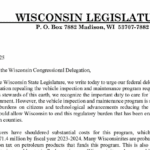By Joe Handrick for Dairyland Sentinel
On Wednesday, I wrote in here about the political contortions Wisconsin’s Supreme Court is being asked to perform to satisfy a hyper-partisan lawsuit aimed at undoing our state’s congressional map. Now, with even more facts laid bare, it’s time to be even more direct: This case is not about fairness. It’s about rigging the process to create outcomes Democrats can’t seem to earn at the ballot box.
Let’s start with some truth the plaintiffs hope you’ll ignore.
The congressional map under attack was drawn in 2011—not by a Republican legislature, but by Wisconsin’s congressional delegation, working together across party lines. Yes, including Democrat Tammy Baldwin. That same map was the foundation for Governor Tony Evers’ 2022 submission, which the liberal-majority state Supreme Court accepted. In 2024, the same court rejected a legal challenge to it—unanimously. Now, plaintiffs want those justices to say they were wrong not once, but twice, and to declare their own approved map unconstitutional. As I pointed out previously, the legal gymnastics required here would rival a Cirque du Soleil act.

The map hasn’t changed—but the politics around it have. And for Democrats, that’s the real issue. Politics.
Here’s what the data shows: in recent statewide races, liberal candidates have consistently won 3 or 4 of the state’s 8 congressional districts. Janet Protasiewicz, Doug LaFollette, Tammy Baldwin—even Barack Obama—all carried four or more districts in various years. Governor Evers himself carried three in 2022, with a near-tie in a fourth. That’s a split decision—not a gerrymandered outcome.
So why do Democrats only hold two congressional seats?
Because, as history shows, their regional congressional candidates don’t perform as well as their top-of-the-ticket statewide stars. In 2008, Obama won 7 of 8 districts—yet Democrats only won 5 House seats. In 2012, Obama carried 4, but Dems won just 3. In 2022, Evers carried 3, yet Democrats managed to win only 2 seats. The pattern is clear.
The problem isn’t the map. It’s the slate of candidates they’ve put up for the US House.
Before the 2011 map even existed, Democrats lost control of one seat when Dave Obey retired. Later, despite a bipartisan effort to help Democrat Ron Kind keep his seat by adding Democratic-leaning Portage County, that seat flipped to the GOP, too. Voters—not lines—caused the shift from a 4–4 delegation to 6–2.
Now, the plaintiffs want the Court to engineer a “fix” by turning competitive seats into guaranteed Democratic ones. Translation: take away competitive districts and force a 4–4 result, not based on voter preference, but judicial fiat. This isn’t based on the law. This isn’t based on precedent. This isn’t democracy—it’s entitlement politics.
It’s all part of a national playbook. As I warned in my recent column, Democrats want to take a bipartisan Wisconsin map and contort it into something resembling Illinois’ infamous gerrymandered mess. The result? Fewer competitive races, more political cynicism, and less trust in our elections.
Let me be blunt: this lawsuit is a political Hail Mary. And fittingly, like the Minnesota Vikings—who inspired the original “Hail Mary” pass—its chances of success are about as real as their Super Bowl hopes.
In Wisconsin, we don’t need gimmicks. Both parties need candidates who can win on ideas and performance—not courtroom maneuvers. Our courts should steer clear of this overtly partisan effort to rewrite election outcomes from the bench.
We’ve got a map that reflects our state’s divided but competitive nature. It’s not perfect, but it’s fair. And until Democrats learn to compete in more places with stronger candidates, no amount of legal trickery is going to deliver the results they want.
Follow Joe on X @JoeMinocqua
Previously at Dairyland Sentinel












